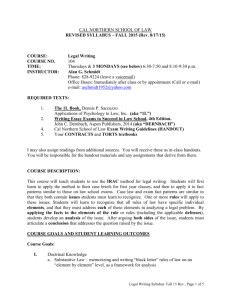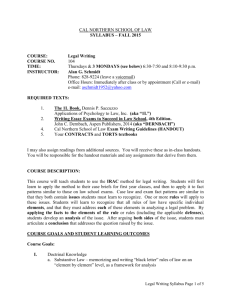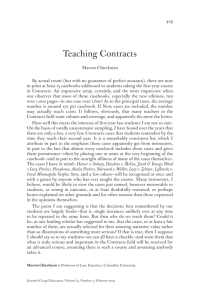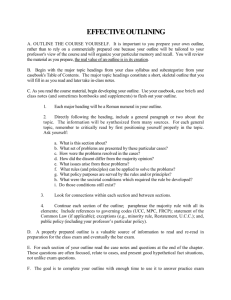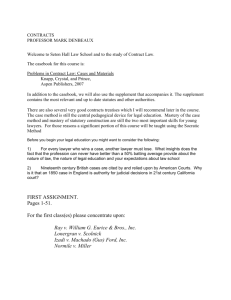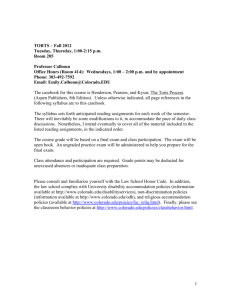- iBrarian.net
advertisement
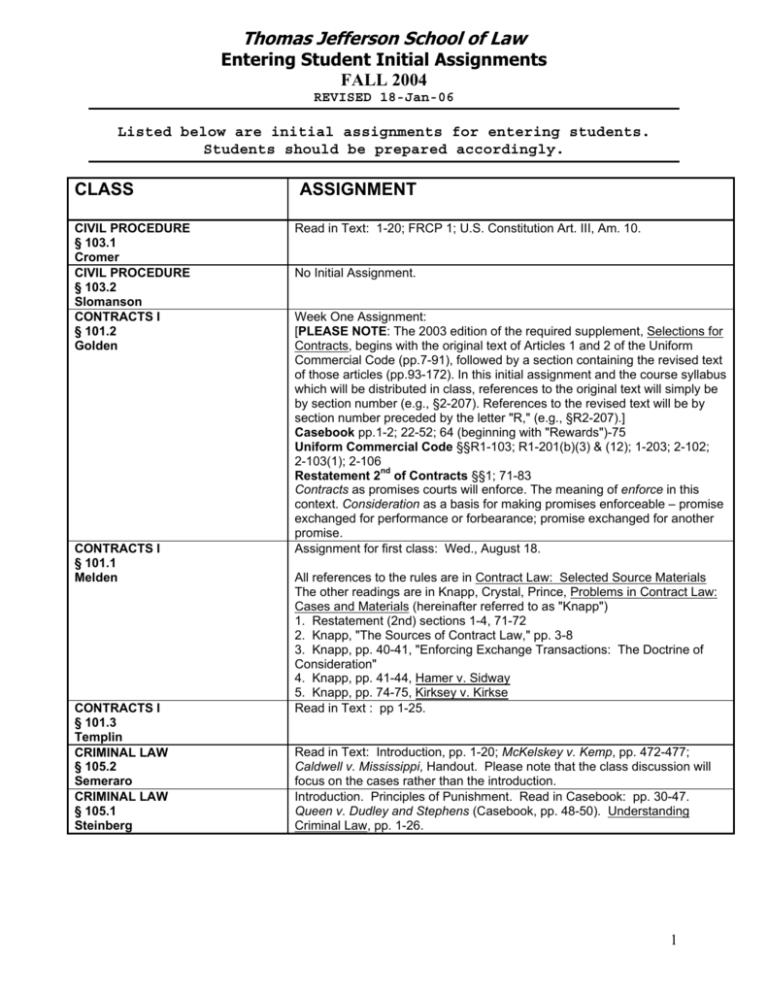
Thomas Jefferson School of Law Entering Student Initial Assignments FALL 2004 REVISED 18-Jan-06 Listed below are initial assignments for entering students. Students should be prepared accordingly. CLASS CIVIL PROCEDURE § 103.1 Cromer CIVIL PROCEDURE § 103.2 Slomanson CONTRACTS I § 101.2 Golden CONTRACTS I § 101.1 Melden CONTRACTS I § 101.3 Templin CRIMINAL LAW § 105.2 Semeraro CRIMINAL LAW § 105.1 Steinberg ASSIGNMENT Read in Text: 1-20; FRCP 1; U.S. Constitution Art. III, Am. 10. No Initial Assignment. Week One Assignment: [PLEASE NOTE: The 2003 edition of the required supplement, Selections for Contracts, begins with the original text of Articles 1 and 2 of the Uniform Commercial Code (pp.7-91), followed by a section containing the revised text of those articles (pp.93-172). In this initial assignment and the course syllabus which will be distributed in class, references to the original text will simply be by section number (e.g., §2-207). References to the revised text will be by section number preceded by the letter "R," (e.g., §R2-207).] Casebook pp.1-2; 22-52; 64 (beginning with "Rewards")-75 Uniform Commercial Code §§R1-103; R1-201(b)(3) & (12); 1-203; 2-102; 2-103(1); 2-106 Restatement 2nd of Contracts §§1; 71-83 Contracts as promises courts will enforce. The meaning of enforce in this context. Consideration as a basis for making promises enforceable – promise exchanged for performance or forbearance; promise exchanged for another promise. Assignment for first class: Wed., August 18. All references to the rules are in Contract Law: Selected Source Materials The other readings are in Knapp, Crystal, Prince, Problems in Contract Law: Cases and Materials (hereinafter referred to as "Knapp") 1. Restatement (2nd) sections 1-4, 71-72 2. Knapp, "The Sources of Contract Law," pp. 3-8 3. Knapp, pp. 40-41, "Enforcing Exchange Transactions: The Doctrine of Consideration" 4. Knapp, pp. 41-44, Hamer v. Sidway 5. Knapp, pp. 74-75, Kirksey v. Kirkse Read in Text : pp 1-25. Read in Text: Introduction, pp. 1-20; McKelskey v. Kemp, pp. 472-477; Caldwell v. Mississippi, Handout. Please note that the class discussion will focus on the cases rather than the introduction. Introduction. Principles of Punishment. Read in Casebook: pp. 30-47. Queen v. Dudley and Stephens (Casebook, pp. 48-50). Understanding Criminal Law, pp. 1-26. 1 CLASS LEGAL WRITING I § 99.4 Berenson LEGAL WRITING I § 99.1, 99.6 Berger ASSIGNMENT Read pages 1-32 (through Exercise 3A) in A Practical Guide to Legal Writing and Legal Method (Dernbach) and read pages 1-14 in the Legal Writing I Workbook. At the first class, you will be expected to turn in a written answer to Exercise 1B on pages 7 and 8 of A Practical Guide to Legal Writing and Legal Method. You should also answer the other exercise questions in Dernbach, but need not turn in those answers. This assignment is meant to get you “into the swing” of legal writing, and will not be graded. Follow the book’s instructions in writing your answer: that is, first, you are to decide each case and explain the reasons for your decision, and second, you are to frame a rule that will reconcile your conclusions and incorporate your reasoning. You should spend no more than one hour, and two typed, double-spaced pages on this assignment. Please write in full sentences and paragraphs. Class 1: Read pages 1-32 (through Exercise 3A) in A Practical Guide to Legal Writing and Legal Method (Dernbach) and read pages 1-17 in the Legal Writing I Workbook. Follow the instructions in the Workbook to prepare the case brief assigned at pages 15-17. At the first class, you also will be expected to turn in a written answer to Exercise 1B on pages 7 and 8 of A Practical Guide to Legal Writing and Legal Method. The written answer to Exercise 1B is a diagnostic writing exercise that will not be graded. Follow the instructions in Dernbach to write your answer: that is, first, you are to decide each case and explain the reasons for your decision, and second, you are to frame a rule that will reconcile your conclusions and incorporate your reasoning. Because I will use your written answers as a diagnostic tool, you should work independently, and you should spend no more than one hour and two double-spaced pages on this assignment. Use full sentences and paragraphs, and type or word process your answer. LEGAL WRITING I § 99.2, 99.5 Durst LEGAL WRITING I § 99.3, 99.7 Keller Please note that you should answer the other exercise questions in Dernbach, but you need not be prepared to turn in the answers. Read pp. 1-32 (through Exercise 3A) in A Practical Guide to Legal Writing and Legal Method (Dernbach) and read pp. 1-17 in the Legal Writing I Workbook. Follow the instructions in the Workbook to prepare the case brief at pp. 15-17. For our first class session, you should read and be prepared to discuss the following: (a) pages 1-14 (Introduction & Case Briefing) in the Legal Writing I Workbook (WB); (b) Suzanne E. Rowe, Legal Research, Legal Writing and Legal Analysis, in WB (see Table of Contents for page numbers); (c) pages 1-32 in A Practical Guide to Legal Writing & Legal Method (Dernbach). You should work through all of the relevant exercises in Dernbach (up to p. 32), but you will hand in only two exercises in class: Ex. 1-B (parts 1 & 2) and Ex. 3-A (Toad v. Ulrich case brief). You must bring TWO copies each of these exercises to class (one to hand in, one to refer to during class discussion). These exercises will serve as diagnostic assignments that will not be graded. Follow the directions in Dernbach; double-space and type (or word process) your answers. You are limited to 2 double-spaced, standard font* pages for each exercise. You should spend no more than 60 minutes on each exercise. Do use full sentences and paragraphs; do not use spell-check or grammarcheck. * For this assignment, standard font means Courier 12-point or larger OR Times New Roman 13-point or larger. 2 CLASS TORTS I § 111.1 Delman TORTS I § 111.3 Kass TORTS I § 111.2 Waldman ASSIGNMENT Please read cases in the order assigned. Read the entire assignment for the first class. Casebook: Concept of Intent, pp. 17-20, 25-28, 23-24; Battery, pp. 29-33; Assault, pp. 33-37. Read in Glannon: pp. 3-5, 6-20, 21-27, 28-38. Prosser Casebook, pp. 1-20 (skip Spivey case) and pp. 22-28 (skip Talmadge case). Do not brief the cases pp. 1-16. Understanding Torts Treatise, pp. 34, 5-7. [Optional: Glannon pp. 3-5] Week One: Read in the Supplement, pp. 1-10 (do this first); in Understanding Torts, pp. 3-7; in the Prosser casebook, pp. 1-16 (do not brief these cases); 17-20 (brief cases); notes on 22-23 (but no need to read Spivey v. Battaglia); 23-28 (brief cases). 3
